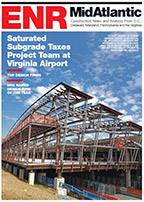"As project managers, we select our own teams and engage in early negotiations with clients to determine scope of work and negotiate fees, understanding that any incentives carry the responsibility of meeting budget and schedule," says Armouti. "We, in turn, empower our team members, seeking input to best serve the project and client."
To enhance design concepts, the firm customarily organizes workshops to unite key stakeholders at a project's inception. "That's the point when you minimize risk and maximize value, rather than at the end stages of design, when value engineering more typically occurs," says Austin.
To bring fresh perspective to concepts, CMT frequently solicits participation from contractors with expertise with a particular project type but no stake in the project. "Designers and builders tend to think on different planes, so early input of that nature is useful for unusual projects," says Greg Law, group manager, highways and bridges, with CMT's St. Louis office.
Contractors typically hail from outside the region to ensure opinions aren't informed by previous experience with the client.
For Missouri's new Interstate 70 interchange, a structure linking three highways—I-70, I-44, I-55—to the Mississippi River's recently completed Stan Musial Veterans Memorial Bridge, CMT recruited the retired owner of a mid-size construction firm specializing in bridges to join members of Missouri Dept. of Transportation (MoDOT) and Federal Highway Administration in reviewing conceptual plans.
Here, a primary issue was budget, with MoDOT and Illinois Dept. of Transportation having revised concepts in order to reduce project costs for bridge and interchange by nearly one-third, to $690 million. Among other concessions, MoDOT agreed to eliminate east and west flyovers from the interchange, providing the footprint to accommodate the two in the future. Even then, says Law, "budgets were extremely tight."
During the workshop, client, design team and contractor developed strategies to further reduce interchange costs. By reversing the positions of current and future flyovers—locating the former closer to grade and the latter higher aloft—they reasoned they could reduce roadway fill and bridge heights while trimming the heights of retaining walls by 20 to 30 ft.
"The solution also resulted in a smaller footprint," says Law.
As built, the reconfigured structure achieved $13.6 million in savings—or 28% of programmed costs—with MoDOT receiving 100% of savings, compared with 50% under a traditional value engineering contractor proposal, which entitles the contractor to the other half. MoDOT allocated the savings to the bridge.
Rewards also are flowing CMT's way. Last year, firm revenue leapt 22%—to $53 million—on the strength of several key projects, including a 280-ft land bridge that will span I-70 to connect downtown St. Louis to Gateway Arch grounds—Phase 1 of the $380-million St. Louis Gateway Arch Grounds Renovation project.






Post a comment to this article
Report Abusive Comment